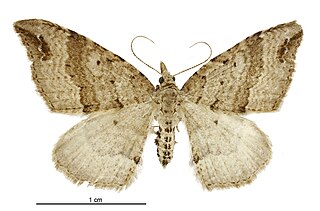
Urodidae, whose species are commonly known as false burnet moths, is a family of moths in the lepidopteran order. It is the type genus in the superfamily, Urodoidea, with three genera, one of which, Wockia, occurs in Europe.
Metachanda is the sole genus in tribe Metachandini of moth subfamily Oecophorinae. Metachandini was originally described as family Metachandidae by Edward Meyrick in 1911, and at the time also contained the genus Chanystis, which is currently unplaced to tribe within Oecophorinae. It has also previously been described as tribe Metachandini of subfamily Gelechiinae.
Agathiphaga is a genus of moths, known as kauri moths. and is the only living genus in the family Agathiphagidae. This caddisfly-like lineage of primitive moths was first reported by Lionel Jack Dumbleton in 1952, as a new genus of Micropterigidae.
Atypha is a monotypic moth genus of the family Noctuidae erected by Jacob Hübner in 1821. Its only species, Atypha pulmonaris, was first described by Eugenius Johann Christoph Esper in 1790. It is found in southern and central Europe, northern Turkey, Transcaucasia and the Caucasus.
Celonoptera is a monotypic moth genus in the family Geometridae. Its only species, Celonoptera mirificaria, is found in south-eastern Europe. Both the genus and species were first described by Julius Lederer in 1862.

Homodotis is a genus of moths in the family Geometridae erected by Edward Meyrick in 1885. All the species in this genus are endemic to New Zealand.
Chaeopsestis is a monotypic moth genus belonging to the family Drepaninae first described by Ferdinand Le Cerf in 1941. Its single species, Chaeopsestis ludovicae, was described in the same paper. It is found in Vietnam, Thailand and the Chinese provinces of Jiangxi, Fujian, Guangdong and Hainan.

Kerala is a genus of moths of the family Nolidae erected by Frederic Moore in 1881.
Aeolosia multipunctata is a moth of the subfamily Arctiinae. It is found in Burma.
Colla aminula is a moth in the family Bombycidae. It was described by Herbert Druce in 1890. It is found in Uruguay.
Trichophysetis aurantidiscalis is a moth in the family Crambidae. It is found in China.
Trichophysetis bipunctalis is a moth in the family Crambidae. It is found in China.
Trichophysetis crocoplaga is a moth in the family Crambidae. It is found in Australia, where it has been recorded from Queensland.
Trichophysetis drancesalis is a moth in the family Crambidae. It is found on Borneo.
Trichophysetis poliochyta is a moth in the family Crambidae. It is found in Australia, where it has been recorded from Queensland.
Trischistognatha limatalis is a moth in the family Crambidae. It is found in Costa Rica.
Semniomima anubisalis is a moth in the family Crambidae. It is found in Brazil.
Semniomima polystrigalis is a moth in the family Crambidae. It is found in Peru.
Semniomima puella is a moth in the family Crambidae. It is found in Brazil.

Epipomponia is a genus of moths in the family Epipyropidae.



